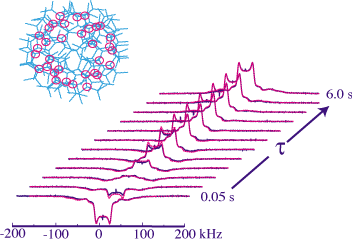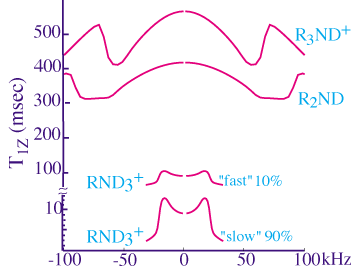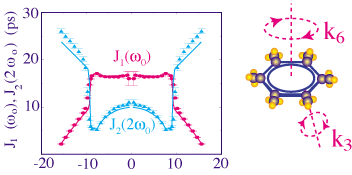Deuteron Spin Relaxation
A major focus of research in our laboratory is to devise new and improved methods of measuring relaxation times, and to develop robust and efficient procedures for their interpretation in terms of motional processes. In particular, we are concerned with spin relaxation in solid materials. In solids, spin interactions such as dipolar coupling, quadrupole coupling, and chemical shift anisotropy are anisotropically averaged by motion: the strongly directional forces present in solids imply that random motions can occur only along specific trajectories. By fitting measured relaxation times to appropriate statistical mechanical models, we can obtain unambiguous, quantitative information about the rates and their associated trajectories. Deuteron spin relaxation is the most widely used NMR technique for probing molecular motion in solids, because the measured relaxation times can usually be interpreted without complications from spin diffusion and other inherently many body problems. There are two different deuteron spin lattice relaxation times: T1Z refers to recovery of Zeeman polarization after an initial perturbation, and T1Q describes the decay of quadrupole order. The relaxing polarization is generally probed with a quadrupole echo pulse sequence, which yields a series of partially relaxed powder patterns as a function of relaxation delay.

Figure 1 shows partially relaxed deuteron quadrupole echo powder patterns of a solid, perdeuterated polyamidoamine (PAMAM) dendrimer salt. This material has an amorphous, globular structure (see inset). For short delay times (tau) , the entire powder pattern is inverted. For ~100 - 200 msec delays the central part of the spectrum has recovered, while the outer wings are still inverted. Full recovery occurs after ~ 6 seconds. The spectrum is composed of overlapping powder patterns from R-ND3+, RR'-ND, and RR'R''-ND+ groups. Each of these powder patterns exhibits a characteristic anisotropy which we can model using our simulation program, EXPRESS:
 The T1Z profiles shown in Figure 2 for ND3+ groups were calculated assuming rapid jumps about a 3-fold axis which itself was allowed to jump among four orientations defining a restricted cone. In order to fit the experimental data (Figure 1) it was necessary to use unequal site occupation probabilities and to include a distribution of cone angles. In addition, about 10% of the terminal ND3+ groups were found to relax ~ 10 fold faster than the others. The data shown here are for a generation 9 dendrimer with 1024 terminal ND3+ groups. A complete analysis of similar data for generations 2, 3, 5, 7, and 9 is reported in Macromolecules 33, 1268 (2000) and Macromolecules 33, 7508 (2000).
The T1Z profiles shown in Figure 2 for ND3+ groups were calculated assuming rapid jumps about a 3-fold axis which itself was allowed to jump among four orientations defining a restricted cone. In order to fit the experimental data (Figure 1) it was necessary to use unequal site occupation probabilities and to include a distribution of cone angles. In addition, about 10% of the terminal ND3+ groups were found to relax ~ 10 fold faster than the others. The data shown here are for a generation 9 dendrimer with 1024 terminal ND3+ groups. A complete analysis of similar data for generations 2, 3, 5, 7, and 9 is reported in Macromolecules 33, 1268 (2000) and Macromolecules 33, 7508 (2000).
Complex motional models can reproduce observed T1Z anisotropy profiles, but the number of adjustable parameters is unfomfortably large. Addtional information, which must be reproducible by the same parameters used to fit T1Z, can be obtained from measurements of the decay time T1Q of quadrupole order. This conclusion is based on the following theoretical considerations. The quadrupole Hamiltonian is rendered time dependent by random motion and contains second rank tensor spin operators, which implies that relaxation proceeds by both one and two-quantum spin flips. The transition probabilities for these spin flips can be expressed in terms of spectral densities J1 and J2, evaluated the Larmor frequency and twice the Larmor frequency, respectively. It can be shown that T1Z and T1Q are linearly independent functions of the two spectral densities:

Thus, by measuring both T1Z and T1Q, it is possible to determine both J1 and J2. In solids, where motion is decidedly restricted and anisotropic, the two spectral densities depend in very different (usually non-linear) ways on the motional model. A good example is provided by hexamethylbenzene-d18:

This molecule rotates about the six-fold axis normal to the ring plane, and each methyl group also rotates about its pseudo-threefold axis. The spectral densities depend in very different ways on the rates k6 and k3: the anisotropy of J1 and J2 is opposite in sign. Many different combinations of k6 and k3 can reproduce T1Z by itself, but as described in J. Chem. Phys. 100, 4756 (1994), a simultaneous fit to both J1 and J2 provides accurate values for both rates.
Future Directions
The advent of very high field spectrometers designed for high power pulses, fast recovery, and wide spectral windows will doubtless greatly extend the applicability of deuteron spin lattice relaxation measurements in materials science. This is one major use of the wide bore 750 MHz spectrometer recently installed at the College of William and Mary. We also envision replacing the quadrupole echo detection piece of typical deuteron relaxation pulse sequences by a single 90 degree pulse, combined with magic angle spinning. Magic angle spinning tends to average the relaxation time anisotropy: whether or not different spinning side bands can exhibit different relaxation rates is at the moment an open question.
In recent years there has been an explosion of interest in nuclei with half-integer spin greater than one, driven by the invention of several techniques for manipulating both the first and second order quadrupole coupling interaction. Relatively little attention has been paid to detailed measurements of their spin lattice relaxation behavior under high resolution conditions. The basic spin dynamics of high spin quadrupole relaxation has been known for many years, and we are in process of extending this methodology to account for relaxation time anisotropy associated with second order quadrupole broadening.














